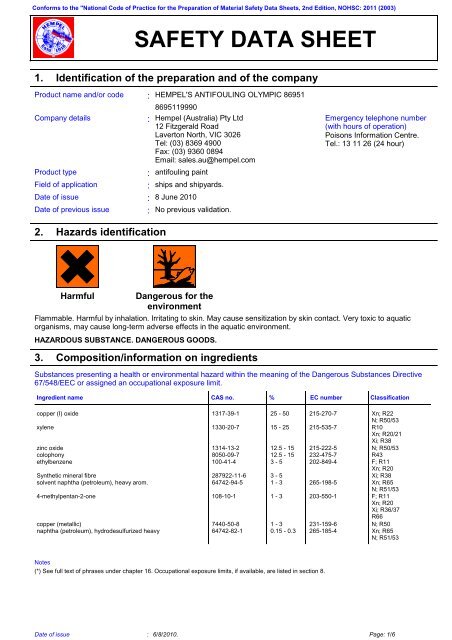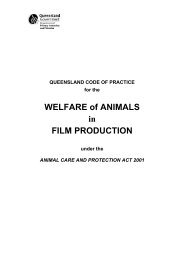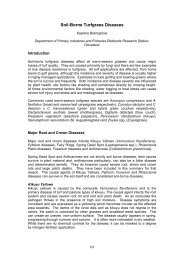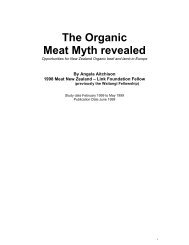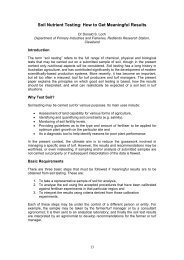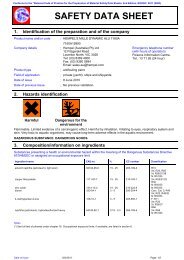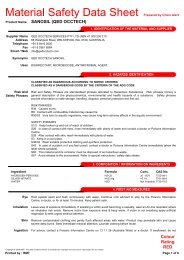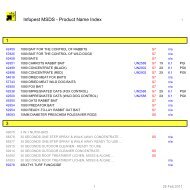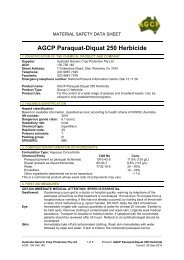9106 8695119990 (English (US)) HEMPEL SDS - Australia
9106 8695119990 (English (US)) HEMPEL SDS - Australia
9106 8695119990 (English (US)) HEMPEL SDS - Australia
Create successful ePaper yourself
Turn your PDF publications into a flip-book with our unique Google optimized e-Paper software.
Conforms to the "National Code of Practice for the Preparation of Material Safety Data Sheets, 2nd Edition, NOHSC: 2011 (2003)<br />
.<br />
1.<br />
.<br />
Product name and/or code<br />
Company details<br />
Product type : antifouling paint<br />
Field of application : ships and shipyards.<br />
Date of issue : 8 June 2010<br />
SAFETY DATA SHEET<br />
Identification of the preparation and of the company<br />
Date of previous issue<br />
.<br />
2.<br />
.<br />
Hazards identification<br />
:<br />
:<br />
:<br />
<strong>HEMPEL</strong>'S ANTIFOULING OLYMPIC 86951<br />
<strong>8695119990</strong><br />
Hempel (<strong>Australia</strong>) Pty Ltd<br />
12 Fitzgerald Road<br />
Laverton North, VIC 3026<br />
Tel: (03) 8369 4900<br />
Fax: (03) 9360 0894<br />
Email: sales.au@hempel.com<br />
No previous validation.<br />
Harmful Dangerous for the<br />
environment<br />
Emergency telephone number<br />
(with hours of operation)<br />
Poisons Information Centre.<br />
Tel.: 13 11 26 (24 hour)<br />
Flammable. Harmful by inhalation. Irritating to skin. May cause sensitization by skin contact. Very toxic to aquatic<br />
organisms, may cause long-term adverse effects in the aquatic environment.<br />
HAZARDO<strong>US</strong> SUBSTANCE. DANGERO<strong>US</strong> GOODS.<br />
.<br />
3.<br />
.<br />
Composition/information on ingredients<br />
Substances presenting a health or environmental hazard within the meaning of the Dangerous Substances Directive<br />
67/548/EEC or assigned an occupational exposure limit.<br />
copper (I) oxide 1317-39-1 25 - 50 215-270-7 Xn; R22<br />
N; R50/53<br />
xylene 1330-20-7 15 - 25 215-535-7 R10<br />
Xn; R20/21<br />
Xi; R38<br />
zinc oxide 1314-13-2 12.5 - 15 215-222-5 N; R50/53<br />
colophony 8050-09-7 12.5 - 15 232-475-7 R43<br />
ethylbenzene 100-41-4 3 - 5 202-849-4 F; R11<br />
Xn; R20<br />
Synthetic mineral fibre 287922-11-6 3 - 5 Xi; R38<br />
solvent naphtha (petroleum), heavy arom. 64742-94-5 1 - 3 265-198-5 Xn; R65<br />
N; R51/53<br />
4-methylpentan-2-one 108-10-1 1 - 3 203-550-1 F; R11<br />
Xn; R20<br />
Xi; R36/37<br />
R66<br />
copper (metallic) 7440-50-8 1 - 3 231-159-6 N; R50<br />
naphtha (petroleum), hydrodesulfurized heavy 64742-82-1 0.15 - 0.3 265-185-4 Xn; R65<br />
N; R51/53<br />
.<br />
Notes<br />
(*) See full text of phrases under chapter 16. Occupational exposure limits, if available, are listed in section 8.<br />
Date of issue : 6/8/2010. Page: 1/6<br />
CAS no. % EC number Classification Ingredient name
<strong>HEMPEL</strong>'S ANTIFOULING OLYMPIC 86951 <strong>8695119990</strong><br />
.<br />
4.<br />
.<br />
Inhalation :<br />
Skin contact<br />
Ingestion<br />
First aid measures<br />
General :<br />
Eye contact :<br />
.<br />
5.<br />
.<br />
Fire-fighting measures<br />
:<br />
:<br />
In all cases of doubt, or when symptoms persist, seek medical attention. Never<br />
give anything by mouth to an unconscious person.<br />
Remove to fresh air. Keep person warm and at rest. If not breathing, if breathing is<br />
irregular or if respiratory arrest occurs, provide artificial respiration or oxygen by<br />
trained personnel. Give nothing by mouth. If unconscious, place in recovery<br />
position and get medical attention immediately.<br />
Check for and remove any contact lenses. Immediately flush eyes with plenty of<br />
water for at least 15 minutes, occasionally lifting the upper and lower eyelids. In all<br />
cases of doubt, or when symptoms persist, seek medical attention.<br />
Remove contaminated clothing and shoes. Wash skin thoroughly with soap and<br />
water or use recognized skin cleanser. Do not use solvents or thinners.<br />
If swallowed, seek medical advice immediately and show this container or label.<br />
Keep person warm and at rest. Do not induce vomiting unless directed to do so by<br />
medical personnel. Lower the head so that vomit will not re-enter the mouth and<br />
throat.<br />
Promptly isolate the scene by removing all persons from the vicinity of the incident if there is a fire. No action shall be<br />
taken involving any personal risk or without suitable training. Fire will produce dense black smoke. Exposure to<br />
decomposition products may cause a health hazard. Cool closed containers exposed to fire with water. Do not release<br />
runoff from fire to drains or watercourses. Fire-fighters should wear appropriate protective equipment and selfcontained<br />
breathing apparatus (SCBA) with a full face-piece operated in positive pressure mode.<br />
Extinguishing media : Recommended: alcohol resistant foam, CO2, powders, water spray.<br />
Not to be used: waterjet.<br />
Fire degradation products : Decomposition products may include the following materials: carbon oxides metal<br />
oxide/oxides<br />
.<br />
6. Accidental release measures<br />
.<br />
Avoid all direct contact with the spilled material. Exclude sources of ignition and be aware of explosion hazard.<br />
Ventilate the area. Avoid breathing vapor or mist. Refer to protective measures listed in sections 7 and 8.<br />
Contain and collect spillage with non-combustible absorbent materials, e.g. sand, earth, vermiculite, diatomaceous<br />
earth, and place in container for disposal according to local regulations (see section 13). Do not allow to enter drains<br />
or watercourses. Clean preferably with a detergent; avoid use of solvents. If the product contaminates lakes, rivers, or<br />
sewers, inform the appropriate authorities in accordance with local regulation.<br />
.<br />
7.<br />
.<br />
Handling and storage<br />
Handling<br />
Vapors are heavier than air and may spread along floors. Vapors may form explosive mixtures with air. Prevent the<br />
creation of flammable or explosive concentrations of vapors in air and avoid vapor concentrations higher than the<br />
occupational exposure limits. In addition, the product should be used only in areas from which all naked lights and<br />
other sources of ignition have been excluded. Electrical equipment should be protected to the appropriate standard.<br />
To dissipate static electricity during transfer, ground drum and connect to receiving container with bonding strap. No<br />
sparking tools should be used.<br />
Avoid inhalation of vapour, dust and spray mist. Avoid contact with skin and eyes. Eating, drinking and smoking should<br />
be prohibited in area where this material is handled, stored and processed. Appropriate personal protective<br />
equipment: see Section 8. Always keep in containers made from the same material as the original one.<br />
Storage<br />
Store in accordance with local regulations for flammable liquids. Store in a cool, well-ventilated area away from<br />
incompatible materials and ignition sources. Keep out of the reach of children. Keep away from: Oxidizing agents,<br />
strong alkalis, strong acids. No smoking. Prevent unauthorized access. Containers that are opened must be carefully<br />
resealed and kept upright to prevent leakage.<br />
Date of issue : 6/8/2010. Page: 2/6
<strong>HEMPEL</strong>'S ANTIFOULING OLYMPIC 86951 <strong>8695119990</strong><br />
.<br />
8.<br />
.<br />
Exposure controls/personal protection<br />
Engineering measures :<br />
Hygiene measures :<br />
Personal protective equipment<br />
General :<br />
Respiratory protection :<br />
Skin protection<br />
Hand protection<br />
Eye protection<br />
:<br />
:<br />
Arrange sufficient ventilation by local exhaust ventilation and good general<br />
ventilation to keep the airborne concentrations of vapors or dust lowest possible<br />
and below their respective threshold limit value. Ensure that eyewash stations and<br />
safety showers are proximal to the work-station location.<br />
Wash hands, forearms, and face thoroughly after handling compounds and before<br />
eating, smoking, using lavatory, and at the end of day.<br />
Ingredient name Occupational exposure limits<br />
xylene Safe Work <strong>Australia</strong> (<strong>Australia</strong>, 8/2005).<br />
STEL: 655 mg/m³ 15 minute(s).<br />
STEL: 150 ppm 15 minute(s).<br />
TWA: 350 mg/m³ 8 hour(s).<br />
TWA: 80 ppm 8 hour(s).<br />
ethylbenzene Safe Work <strong>Australia</strong> (<strong>Australia</strong>, 8/2005).<br />
STEL: 543 mg/m³ 15 minute(s).<br />
STEL: 125 ppm 15 minute(s).<br />
TWA: 434 mg/m³ 8 hour(s).<br />
TWA: 100 ppm 8 hour(s).<br />
solvent naphtha (petroleum), heavy arom. ASCC (<strong>Australia</strong>).<br />
TWA Tentativ: 25 ppm 8 hour(s).<br />
4-methylpentan-2-one Safe Work <strong>Australia</strong> (<strong>Australia</strong>, 8/2005).<br />
STEL: 307 mg/m³ 15 minute(s).<br />
STEL: 75 ppm 15 minute(s).<br />
TWA: 205 mg/m³ 8 hour(s).<br />
TWA: 50 ppm 8 hour(s).<br />
naphtha (petroleum), hydrodesulfurized heavy Safe Work <strong>Australia</strong> (<strong>Australia</strong>).<br />
TWA: 25 ppm 8 hour(s).<br />
TWA: 145 mg/m³ 8 hour(s).<br />
.<br />
9.<br />
.<br />
Physical and chemical properties<br />
Physical state<br />
Density<br />
Solubility<br />
Gloves must be worn for all work that may result in soiling.<br />
Apron/coveralls/protective clothing must be worn when soiling is so great that<br />
regular work clothes do not adequately protect skin against contact with the<br />
product. Safety eyewear should be used when there is a likelihood of exposure.<br />
If working areas have insufficient ventilation: When the product is applied by<br />
means that will not generate an aerosol such as, brush or roller wear half or totally<br />
covering mask equipped with gas filter of type A, when grinding use particle filter<br />
of type P. When the product is applied by spraying and for continuous or<br />
prolonged work always wear an air-fed respirator e.g. hood with supply of fresh or<br />
compressed air or a full face, powered air purifying filter. Be sure to use an<br />
approved/certified respirator or equivalent.<br />
This product contains low-boiling point liquids. Any respiratory protective<br />
equipment should be air-fed.<br />
Wear suitable protective clothing. Always wear protective clothing when spraying.<br />
Wear suitable gloves. For prolonged or repeated handling, use gloves. Barrier<br />
creams may help to protect the exposed areas of the skin, but should not be<br />
applied once exposure has occurred. Barrier creams may not be used under or<br />
instead of gloves.<br />
Since the actual work situation is unknown. Supplier of gloves should be<br />
contacted in order to find the appropriate type.<br />
: Use safety eyewear designed to protect against splash of liquids.<br />
:<br />
:<br />
:<br />
Liquid.<br />
1.78 g/cm 3<br />
Partially soluble in the following materials: cold water and hot water.<br />
Flash point : Closed cup: 27°C (80.6°F)<br />
Explosion limits<br />
: 0.5 - 8 vol %<br />
Solvent(s) % by weight : Weighted average: 25 %<br />
Water % by weight : Weighted average: 0 %<br />
VOC content : Weighted average: 440 g/l (Calculated value for the mixture)<br />
Date of issue : 6/8/2010. Page: 3/6
<strong>HEMPEL</strong>'S ANTIFOULING OLYMPIC 86951 <strong>8695119990</strong><br />
TOC Content : Weighted average: 391 g/l<br />
Solvent Gas : Weighted average: 0.1 m 3 /l<br />
.<br />
10.<br />
Stability and reactivity<br />
.<br />
Stable under recommended storage and handling conditions (see section 7).<br />
Highly reactive or incompatible with the following materials: oxidizing materials, reducing materials and acids.<br />
Reactive or incompatible with the following materials: organic materials, metals and alkalis.<br />
When exposed to high temperatures (i.e. in case of fire) harmful decomposition products may be formed:<br />
Decomposition products may include the following materials: carbon oxides metal oxide/oxides<br />
.<br />
11.<br />
.<br />
Toxicological information<br />
Effects and symptoms<br />
Exposure to component solvent vapor concentrations may result in adverse health effects such as mucous membrane<br />
and respiratory system irritation and adverse effects on the kidneys, liver and central nervous system. Solvents may<br />
cause some of the above effects by absorption through the skin. Symptoms and signs include headaches, dizziness,<br />
fatigue, muscular weakness, drowsiness and, in extreme cases, loss of consciousness. Repeated or prolonged<br />
contact with the preparation may cause removal of natural fat from the skin, resulting in non-allergic contact dermatitis<br />
and absorption through the skin. If splashed in the eyes, the liquid may cause irritation and reversible damage.<br />
Accidental swallowing may cause stomach pain. Chemical lung inflammation may occur if the product is taken into the<br />
lungs via vomiting.<br />
Sensitization : Contains colophony. May produce an allergic reaction.<br />
Acute toxicity<br />
Ingredient name<br />
Result Dose<br />
Species<br />
copper (I) oxide LD50 Oral 470 mg/kg Rat<br />
xylene LC50 Inhalation Gas. 5000 ppm Rat<br />
LD50 Dermal >1700 mg/kg Rabbit<br />
LD50 Oral 4300 mg/kg Rat<br />
zinc oxide LD50 Oral >8437 mg/kg Rat<br />
colophony LD50 Oral >2000 mg/kg Rat<br />
ethylbenzene LD50 Dermal >5000 mg/kg Rabbit<br />
LD50 Oral 3500 mg/kg Rat<br />
solvent naphtha (petroleum), heavy arom. LC50 Inhalation Vapor >590 mg/m3 Rat<br />
LD50 Dermal >2 mL/kg Rabbit<br />
4-methylpentan-2-one LD50 Dermal >3 g/kg Rabbit<br />
LD50 Oral 4600 mg/kg Rat<br />
copper (metallic) TDLo Oral 0.01 mg/kg Human<br />
<strong>HEMPEL</strong>'S ANTIFOULING OLYMPIC 86951 LD50 Dermal >2000 mg/kg Rat<br />
LD50 Oral >2000 mg/kg Rat<br />
.<br />
12.<br />
.<br />
Ecological information<br />
Do not allow to enter drains or watercourses. Very toxic to aquatic organisms, may cause long-term adverse effects in<br />
the aquatic environment.<br />
Ingredient name Species Result<br />
Exposure<br />
copper (I) oxide Acute EC50 0.042 mg/L Fresh water Daphnia - Daphnia similis 48 hours<br />
Acute LC50 0.075 mg/L Fresh water Fish - Danio rerio 96 hours<br />
xylene Acute LC50 8500 ug/L Marine water Crustaceans - Palaemonetes pugio 48 hours<br />
Acute LC50 8200 - 10032 ug/L Fresh water Fish - Oncorhynchus mykiss 96 hours<br />
zinc oxide Acute LC50 98 ug/L Fresh water Daphnia - Daphnia magna 48 hours<br />
Acute LC50 1.1 - 2.5 ppm Fresh water Fish - Oncorhynchus mykiss 96 hours<br />
ethylbenzene Acute EC50 2930 - 4400 ug/L Fresh water Daphnia - Daphnia magna 48 hours<br />
Acute LC50 >5200 ug/L Marine water Crustaceans - Americamysis bahia 48 hours<br />
Acute LC50 280 - 290 ppm Marine water Fish - Cyprinodon variegatus 96 hours<br />
Chronic NOEC 3300 ug/L Marine water Fish - Menidia menidia 96 hours<br />
4-methylpentan-2-one Acute LC50 505000 - 514000 ug/L Fresh water Fish - Pimephales promelas 96 hours<br />
copper (metallic) Acute EC50 0.036 mg/L Daphnia 48 hours<br />
Acute LC50 0.0103 mg/L Fish 96 hours<br />
.<br />
13.<br />
.<br />
Disposal considerations<br />
The generation of waste should be avoided or minimized wherever possible.<br />
Residues of the product is listed as hazardous waste. Dispose of according to all state and local applicable<br />
regulations.<br />
Spillage, remains, discarded clothes and similar should be discarded in a fireproof container.<br />
Date of issue : 6/8/2010. Page: 4/6
<strong>HEMPEL</strong>'S ANTIFOULING OLYMPIC 86951 <strong>8695119990</strong><br />
.<br />
14. Transport information<br />
Transport may take place according to national regulation or ADR for transport by road, RID for transport by train,<br />
IMDG for transport by sea.<br />
The transport classification is according to ADR 2009, IMDG edition 2008 (incl. Amdt. 34-08).<br />
ADG<br />
Class<br />
UN no. Proper shipping name Class PG* Label Additional information<br />
UN1263<br />
PAINT<br />
IMDG Class UN1263 PAINT. (copper (I) oxide) 3 III<br />
PG* : Packing group<br />
.<br />
15.<br />
Contains<br />
Regulatory information<br />
Symbol : Harmful, Dangerous for the environment<br />
Risk phrases<br />
Safety phrases<br />
:<br />
:<br />
:<br />
S23- Do not breathe vapor or spray.<br />
S24- Avoid contact with skin.<br />
S37- Wear suitable gloves.<br />
S51- Use only in well-ventilated areas.<br />
3<br />
III<br />
ADR Tunnel Code: (E)<br />
H-14<br />
Emergency schedules<br />
(EmS)<br />
F-E, S-E<br />
P<br />
Marine pollutant<br />
.<br />
Classification and labeling have been determined according to EU Directives 67/548/EEC and 1999/45/EC (including<br />
amendments) and take into account the intended product use.<br />
Product use :<br />
xylene<br />
colophony<br />
R10- Flammable.<br />
R20- Harmful by inhalation.<br />
R38- Irritating to skin.<br />
R43- May cause sensitization by skin contact.<br />
R50/53- Very toxic to aquatic organisms, may cause long-term adverse effects in<br />
the aquatic environment.<br />
IMO Anti-fouling System Convention Compliant (AFS/CONF/26)<br />
This product does not contain organotin compounds acting as biocides and complies with the International Convention<br />
on the Control of Harmful Anti-fouling Systems on Ships as adopted by IMO October 2001 (IMO document<br />
AFS/CONF/26)<br />
Product type : antifouling paint<br />
Manufacturer : Hempel A/S<br />
Product name and/or code<br />
Colour : Black.<br />
:<br />
Industrial applications, Used by spraying.<br />
<strong>HEMPEL</strong>'S ANTIFOULING OLYMPIC 86951<br />
<strong>8695119990</strong><br />
Note: This name is shown on the product container. All products in <strong>HEMPEL</strong>'s containers carrying this name comply<br />
with the IMO Convention (AFS/CONF/26).<br />
Active ingredient(s) : dicopper oxide 1317-39-1<br />
.<br />
16. Additional information<br />
Full text of R-phrases referred to in<br />
the Safety Data Sheet<br />
Date of issue : 6/8/2010. Page: 5/6<br />
: R11- Highly flammable.<br />
R10- Flammable.<br />
R20- Harmful by inhalation.<br />
R22- Harmful if swallowed.<br />
R20/21- Harmful by inhalation and in contact with skin.<br />
R65- Harmful: may cause lung damage if swallowed.<br />
R38- Irritating to skin.<br />
R36/37- Irritating to eyes and respiratory system.<br />
R43- May cause sensitization by skin contact.<br />
R66- Repeated exposure may cause skin dryness or cracking.<br />
R50- Very toxic to aquatic organisms.<br />
R50/53- Very toxic to aquatic organisms, may cause long-term adverse effects in the aquatic<br />
environment.<br />
R51/53- Toxic to aquatic organisms, may cause long-term adverse effects in the aquatic environment.<br />
Yes.
<strong>HEMPEL</strong>'S ANTIFOULING OLYMPIC 86951 <strong>8695119990</strong><br />
Notice to reader<br />
Modified data or content compared with the previous version are maked with a triangular marker in the upper-left<br />
corner within the Safety Data Sheet.<br />
The information contained in this safety data sheet is based on the present state of knowledge and EU and national<br />
legislation. It provides guidance on health, safety and environmental aspects for handling the product in a safe way<br />
and should not be construed as any guarantee of the technical preformance or suitability for particular applications.<br />
It is always the duty of the user/employer to ascertain that the work is planned and carried out in accordance with the<br />
national regulations.<br />
Date of issue : 6/8/2010. Page: 6/6


